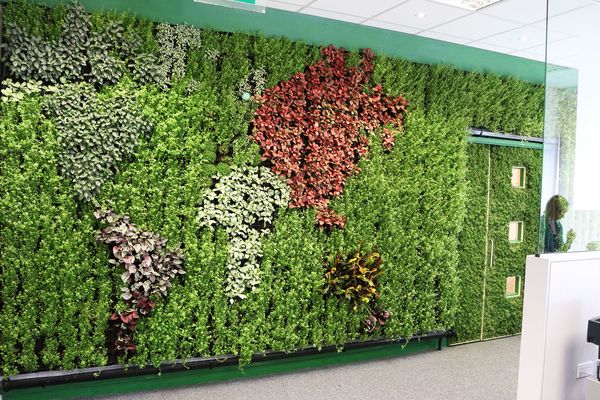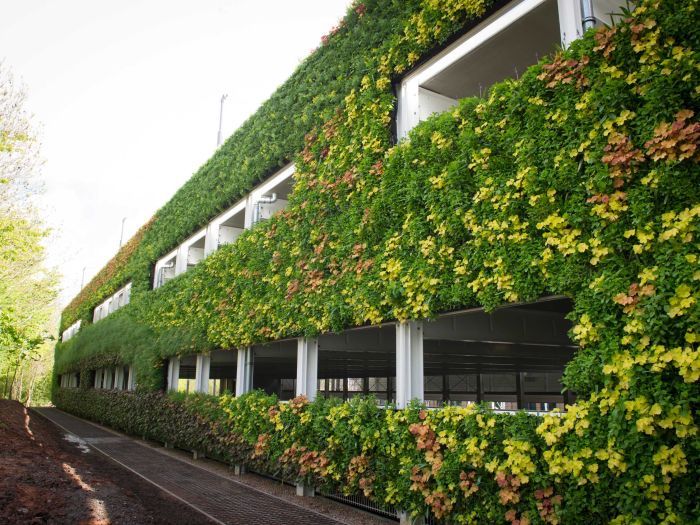As urbanization increases, our cities are getting unhealthy. The world is already facing a crisis and cities like Beijing aren’t witnessing a true sunrise anymore. By the year 2030, the urban landscape across the globe with more than double and this will be at the cost of our natural green cover. The only scope of hope is the most of the future developments will be centered on small and upcoming locations/neighborhoods. This is also the opportunity to add more green space to our neighborhood. Gardens today are a luxury and in most cases, they are impossible to maintain due to lack of space. The next best thing is to accommodate green spaces inside our premises. Therein arises the concept of “Living Walls” or “green Walls”.
Green walls are like vertical gardens that can be integrated to both the interior and exterior of a building. As opposed to green facades, living walls offer the structural support for plants to root themselves and also to receive their necessary nutrients from the vertical support and not the earth below. Verticals gardens don’t need too much of work and are easy to maintain and design. Apart from sucking in pollutants they also liven up your space!
Everything about Living Wall

The concept of green walls arose as a necessity. The idea was put forth by Stanley Hart White in the year 1938. However, the real work was led by Patrick Blank with his revolutionary green walls at Musee du Quai Branly, Paris. Also referred to as the ‘vegetal wall’, his designs brought in a revolution in sustainable architecture and today, the whole world is adopting the concept into its concrete premises.
What are they made of?
A designated vertical space is strategically designed to allow resilient plants to grow their roots and cover the space. Various proprietary systems have been used for this purpose but the simplest tool is a wire mesh against a vertical wall. The plants retain water and minerals through a special system and the complicacy of the same is based on the specific needs of a client.
Types of Living Walls
The type of green walls depends highly on the location and the amount of natural exposure. Consequently, indoor green walls will have a different design than an outdoor one, where sunshine would be plenty. Also, the plants can be chosen according to their texture and color to add beauty to the space. Basically, three types of living walls are common today and include:
- Panel Systems – pre-grown plants in panels that can be moved inside or outside
- Versa Walla – Pre-grown installation to be used indoors
- Freestanding walls – movable walls that can be put anywhere.
Where can it be used?
Living walls can be integrated anywhere, be it inside your house, the exterior of your office, extensive garden projects and even in commercial spaces. They can also be made a part of public infrastructure, as has been in many cases across the globe.
Features
Green walls can easily be accompanied with a custom design feature. While there are several factors to be decided before implementing the green design, there is a great range in flexibility.
Maintenance
Green Wall designs take care of themselves and come fitted with automatic water systems. This water system also provides the necessary nutrients to the plants to grow. Green walls mostly feature resilient plants that can grow with minimal care. However, the design might need regular pruning to keep the look intact.
Far Beyond Aesthetics
- Natural insulation: Green cover, be it through natural greenery or planted installations like living walls offer a high degree of insulation to buildings. They keep the indoors cool in summers and warm in the winters by regulating heat. In fact, green walls tend to make spaces 10 degrees cooler without artificial HVAC systems.
- Reduces energy consumption: High degree of insulation automatically reduces the energy costs of the household/office.
- Maintains humidity levels: Plants absorb moisture and regulate the humidity at comfortable levels.
- Improves air quality: Plants, indoors or outdoors suck in carbon dioxide to give oxygen and purify the air you breathe, thus improving the overall air quality.
- Reduces Noise Levels: Plants don’t just act as temperature insulators but also absorb noise.
- Means of water reuse: Rainwater and discarded water can be easily put into the living wall system without the need to pay for it.
- Improves a building’s appearance: Well maintained (pruned) green walls always heighten the aesthetics of any space.
- Creates Positive Impact: With greenery around, productivity increases. Having plants also offers you a healthier living/working space.
Why Should India Look to More Living Walls?
Climate change today is no more a myth. Indian cities like Delhi have already witnessed how pollution can completely change our routine other than making us ill. Living Walls can make a lot of difference by balancing the environment we live, work or play.
Green walls are easy to install and can also be a DIY project. time has come when our cities need more trees and plants than concrete pavements and smart buildings.
http://reborn-babies-dolls.com/amazing-hand-made-reborn-doll-clothing/ Featured Image
http://sjfiremuseum.org/company/staff-and-volunteers/ Curated by editor at Wienerberger India
Like this story? Or have something to share? Write to us: gosmartbricks@gmail.com or connect with us on Facebook and Twitter.












